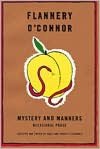Near the beginning of her essay, “The Teaching of Literature” (in Mystery and Manners), Flannery O’Connor writes that fiction  has no dearth of critics, because everyone considers himself an authority on fiction’s central subject. That is, life. So readers tend to be looking for something in particular when they pick up a novel, “and if they find what they want, or at least what they can recognize, then they judge the piece of fiction to be superior.”
has no dearth of critics, because everyone considers himself an authority on fiction’s central subject. That is, life. So readers tend to be looking for something in particular when they pick up a novel, “and if they find what they want, or at least what they can recognize, then they judge the piece of fiction to be superior.”
O’Connor writes that she was halfway through her Master’s degree in English before she even understood what fiction was, “and I doubt if I would ever have learned then, had I not been trying to write it.” Speaking for myself, I think there are two reasons for this. First, as she said, everyone has a life. Second, almost anyone can be taught to write with some competence. The tools of language are close at hand and every minimally-educated person has some acquaintance with them. Familiarity breeds a certain form of contempt, as you know if you’ve ever read a crummy novel and thought, I could write a better one than that. Possibly you can, but as one who’s written several unpublishable novels and read many more, I can say it’s a lot harder than it looks.
Before teaching literature, a literature teacher might first take the time to ask, Why do I read novels? What do I want from fiction? The Why should help determine the How.
 Literature is the common-core subject that seems least able to justify itself. We can see the need for learning to read, write, and figure, as well as have some passing acquaintance with history and science. But the value of appreciating Dickens or Dickenson is harder to explain, much less justify Shakespeare to a lad struggling over Macbeth’s iambic pentameter. This is a generation—or actually several generations–who have “been made to feel that the aim of learning is to eliminate mystery.” And mystery, according to O’Connor, is the precisely the realm of literature: “It is the business of fiction to embody mystery through manners,” the mystery being the awesome fact of human existence and the manners being the literary conventions that illuminate it.
Literature is the common-core subject that seems least able to justify itself. We can see the need for learning to read, write, and figure, as well as have some passing acquaintance with history and science. But the value of appreciating Dickens or Dickenson is harder to explain, much less justify Shakespeare to a lad struggling over Macbeth’s iambic pentameter. This is a generation—or actually several generations–who have “been made to feel that the aim of learning is to eliminate mystery.” And mystery, according to O’Connor, is the precisely the realm of literature: “It is the business of fiction to embody mystery through manners,” the mystery being the awesome fact of human existence and the manners being the literary conventions that illuminate it.
Our present age long ago lost the core meaning of “liberal education” (the education of a free man, or that which contributes to the life of the mind rather than the necessity of earning a living). We tend to think that “art must be utilitarian, that it must do something, rather than be something.” At the very least (we think), it should give us the information necessary to pass a standardized test! In high school and college, literature is often taught as social theory or psychological study (of the author, if nothing else) or even as a moral lesson, though this use of fiction is not as explicit as it was in the days of McGuffey Readers. In elementary schools and home schools, we see literature as a tool for teaching good character traits or confirming our beliefs, and partially for conveying knowledge. And certainly kids need to read in order to improve their reading skills. (Even though the purpose for improving their reading skills is often less clear.)
Stories and novels can do all that. But really good fiction can do a lot more. The problem is that fiction works in a very subtle manner, and what deeply stirs one reader will barely touch another. So what’s a teacher to do?
O’Connor’s suggestion surprises me: any high school or college program should begin with the technical aspects of fiction:
The student has to have tools to understand a story or a novel, and these are tools proper to the structure of the work, tools proper to the craft. They are tools that operate inside the work and not outside it; they are concerned with how this story is made and with what makes it work as a story.
It’s been a long time since I took a college class, so I have to guess at what she means here. Even fifth-graders are taught that a story must have a “problem,” characters, plot, setting, and details, and they’re encouraged to include all those things when they write them. I suspect that the teaching of fiction doesn’t go far beyond that in high school, or even at the college level. But plot, character, etc. are just elements of fiction; the dynamic interplay of these elements constitutes the “manners” of fiction, or the way that a story is told. Why does the author choose the scenes and the sequence she does? Why third person instead of first person (or vice versa)? Which of the characters move the action, and which react? Does the antagonist seem more interesting than the protagonist? “In the act of writing, one sees that the way a thing is made controls and is inseparable from the whole meaning of it.”
Here’s a key to reading Flannery O’Connor, shared by the author herself: “I believe that the basic experience of everyone is the experience of human limitation.” As Jonathan Rogers explained in Emily’s interview with him yesterday, her characters obviously need Jesus. Depravity is not an abstract concept for them. “Human limitation” is partly what the fifth-grade teacher means when she tells her class that every story must have a problem, but the biblical truth underlying that fact is that we make our own problems, or some other limited/depraved person contributes to them. Much of the fiction we love is all about overcoming problems, and there’s nothing wrong with that, so long as it doesn’t create false confidence in the Christian. But the best fiction shows (without preaching) that only Christ can solve our problems, and the truly blessed are the ones who know that first.
For more on reading and teaching literature, see our interview with Alan Jacobs and review of his recent book, The Pleasures of Reading in an Age of Distraction.
Support our writers and help keep Redeemed Reader ad-free by joining the Redeemed Reader Fellowship.
Stay Up to Date!
Get the information you need to make wise choices about books for your children and teens.
Our weekly newsletter includes our latest reviews, related links from around the web, a featured book list, book trivia, and more. We never sell your information. You may unsubscribe at any time.
We'd love to hear from you!
Our comments are now limited to our members (both Silver and Golden Key). Members, you just need to log in with your normal log-in credentials!
Not a member yet? You can join the Silver Key ($2.99/month) for a free 2-week trial. Cancel at any time. Find out more about membership here.
2 Comments
Leave a Comment
You must be logged in to post a comment.


I am so enjoying this series.
Thank you!
Thanks, Becky! You have a lovely site, by the way.